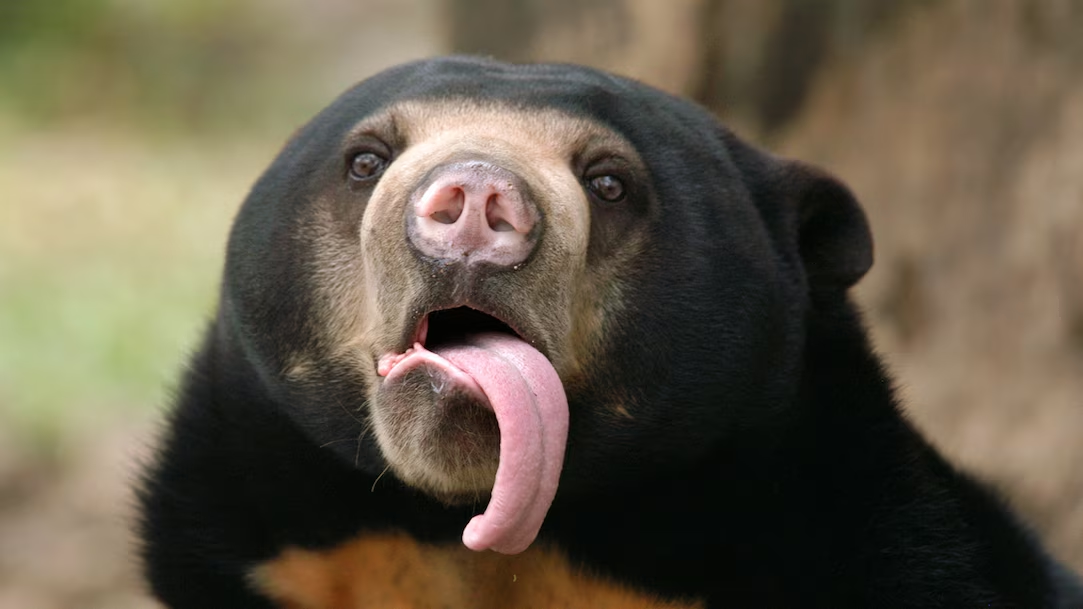When people think of bears, they often picture massive grizzlies fishing in Alaskan rivers or polar bears roaming icy tundras.
But far away in the tropical rainforests of Southeast Asia lives a bear that’s very different from its larger, colder-climate cousins — the sun bear.
Tiny by bear standards, secretive by nature, and rare in the wild, the sun bear is one of the least known and most threatened bear species on Earth. With its short black fur, long tongue, and a chest patch that resembles a rising sun, this bear is both adorable and important — yet few people have ever heard of it.
Let’s take a closer look at this fascinating animal, the threats it faces, and why it deserves much more attention than it gets.
Meet the Sun Bear
The sun bear (Helarctos malayanus) is the smallest member of the bear family. On average, adult sun bears stand just about 70 cm (28 inches) at the shoulder and weigh between 25 to 65 kilograms (55 to 143 pounds). That makes them about the size of a large dog — quite petite compared to their polar or brown bear relatives.
Sun bears are found primarily in the tropical forests of Southeast Asia, including countries like Malaysia, Indonesia, Thailand, Myanmar, Laos, Cambodia, and Vietnam. They’re also known as “honey bears”, thanks to their deep love of honey and their remarkably long tongues (up to 20–25 cm) used to extract it from hives and tree crevices.
What’s With the “Sun” Name?
The sun bear gets its name from the crescent-shaped patch of lighter fur on its chest, which is usually orange, yellow, or cream-colored. This marking is unique to each bear, like a fingerprint, and stands out against their otherwise short, sleek black coat.
According to local legends, the patch represents the rising sun, believed to offer protection from evil spirits. Scientists aren’t sure of its evolutionary purpose, but it certainly makes the sun bear easy to identify.
Life in the Trees
Sun bears are arboreal, which means they spend a lot of time in the trees. With their curved claws and strong limbs, they’re excellent climbers and often build nests in the treetops to sleep, rest, or escape predators.
Their diet is omnivorous and varied. In the wild, sun bears eat:
- Insects like termites, ants, and beetle larvae
- Fruit, especially figs and durians
- Honey and beehives
- Small birds and eggs
- Sometimes small reptiles or rodents
Their long claws are perfect for tearing into tree bark or rotten logs to uncover hidden insect meals.
🤫 A Solitary, Shy Lifestyle
Sun bears are solitary and secretive, which makes them difficult to study in the wild. Unlike some bear species that hibernate, sun bears are active year-round, thanks to their warm, tropical habitats. They tend to be nocturnal or crepuscular (active at dawn and dusk), and they rarely interact with humans — unless their habitat is disturbed.
Because of their elusive nature, even wildlife biologists are still learning about their behavior and ecology.
Endangered and Often Overlooked
Unfortunately, the sun bear is listed as “Vulnerable” on the IUCN Red List, and its population is rapidly declining. In some regions, it’s feared they may be approaching “Critically Endangered” status. The exact number of sun bears left in the wild is unknown, but estimates suggest the population has dropped by over 30% in the last 30 years.
The main threats to sun bears include:
1. Habitat Loss
Deforestation for palm oil plantations, illegal logging, and agricultural expansion is destroying the sun bear’s natural habitat at an alarming rate. Once the forest is gone, sun bears have nowhere to live, feed, or hide.
2. Poaching and Illegal Pet Trade
Sun bears are hunted for their gallbladders and bile, used in traditional medicine. Cubs are often taken from the wild and sold as exotic pets, often after their mothers are killed.
3. Human-Wildlife Conflict
As forests shrink, sun bears sometimes venture into farms or villages in search of food, which can lead to them being killed by frightened locals.
Conservation Efforts
Several organizations are working to protect the sun bear and its habitat. Sanctuaries like the Bornean Sun Bear Conservation Centre (BSBCC) in Sabah, Malaysia, rescue bears from captivity and educate the public about their importance.
Conservation efforts focus on:
- Rescuing and rehabilitating captive sun bears
- Promoting sustainable forestry and palm oil production
- Educating local communities about the ecological role of sun bears
- Strengthening anti-poaching laws and enforcement
You can help by supporting sustainable products, particularly palm oil certified by the RSPO (Roundtable on Sustainable Palm Oil), and by spreading awareness about the species.
Why Sun Bears Matter
Despite their small size, sun bears play a big role in maintaining the health of their ecosystem.
- By tearing apart trees and logs to feed, they help control insect populations and create nesting sites for birds and small animals.
- Their fruit-heavy diet makes them important seed dispersers, helping regenerate the forest.
- Their presence is an indicator of a healthy, intact rainforest.
In short, saving the sun bear helps save the forest — and everything that lives in it.
Final Thoughts
The sun bear may not have the star power of pandas or polar bears, but it’s a remarkable and vital creature deserving of our attention and protection. Quiet, mysterious, and endearing, it represents a world that’s fast disappearing: the lush, untouched rainforests of Southeast Asia.
If more people knew about the sun bear — and the threats it faces — we might have a better chance of keeping this little forest guardian around for future generations.

